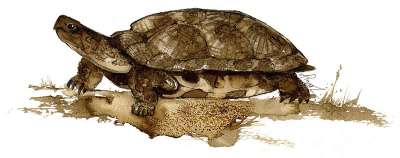
Years ago, I stopped when I saw a turtle attempting to cross a high-traffic road. When I picked it up, I noticed its intricately sculpted shell. The top, or carapace, was covered with layers of bony scales, called scutes, which formed small pyramids circled by concentric growth rings. Finely spaced ridges radiated from each apex. The unusual shell and orange skin helped me identify it as a wood turtle, a species being considered for federal listing as endangered because populations have declined in most northeastern states.
Pyramidal, domed, smooth, leathery — turtle shells come in all shapes, sizes and designs. Their ribs are fused to the carapace. On the underside of a turtle, the lower shell, or plastron is connected to the carapace at the sides by a bony bridge. The pelvis and shoulders are tucked inside the shell. A recent discovery of several 260-million-year-old fossil proto-turtles in South Africa (one by an eight-year-old boy on his father’s farm) suggests that the turtle’s shell was originally an adaptation for burrowing underground. Over time the shell evolved into a protective device, from which turtles watched both the rise and fall of the dinosaurs.
The growth process of scutes on a turtle’s carapace varies among species and affects the strength of the shell, explained herpetologist Jim Andrews. Some turtles, such as the painted turtle, one of our most common species, have deciduous scutes, meaning they are shed. As the turtle grows, old scutes peel off, creating a thin, smooth, lightweight shell that helps this aquatic turtle swim. In contrast, the wood turtle has non-deciduous scutes. As this turtle grows, the old scutes are pushed upwards, yielding the pyramids of scutes that I observed on my rescue turtle. Many layers of scutes stuck together give the wood turtle a tougher, stronger shell. “It’s laminated, like plywood,” observed Andrews.
Each turtle species’ shell is adapted to its particular lifestyle. The wood turtle spends half its time on land, foraging for worms, insects, and berries in woodlands and meadows. When a fox or raccoon approaches, the turtle withdraws its head and legs into its armored shell. The reduced, cross-shaped plastron of the snapping turtle doesn’t offer as comprehensive a defense (snappers can’t pull into their shells), but facilitates walking on pond bottoms. (The aggressive temperament and powerful jaws of the snapping turtle make up for this lack of shell.) The spiny softshell turtle, a rare species in our region, has an unusual shell. Its flat, circular carapace with no scutes is hidden beneath a leathery skin. This flexible shell isn’t as good for defense, but facilitates speed both on land and water.
For most turtles in the Northeast, shells serve another, critical purpose – as a mineral reserve that helps them maintain body chemistry over winter. The painted turtle, for example, hibernates in the murky bottom of ponds and other waterbodies. Though it normally breathes air through its lungs, in winter its heart and breathing rate slow and its organs almost shut down, allowing the turtle to survive in a low-oxygen environment beneath the ice. Its body burns stored fat and sugars; although metabolizing fat in the absence of oxygen creates lactic acid and if this acid builds up, it can be fatal. Fortunately for the turtle, its shell and skeleton release calcium and other carbonates that neutralize the acid. The shell also absorbs and stores the buffered acid.
One might wonder how spiny softshell turtles survive the winter, since they don’t have much of a shell to release carbonates. According to Andrews, they choose places in rivers or lakes where there is water flow, which increases oxygen levels. Andrews participated in a study of spiny softshells that required changing the batteries of the turtles’ radio transmitters in winter. Divers found the turtles buried in an inch or two of muck under Lake Champlain, but within neck reach of the water. When biologists, waiting in boats above, examined the turtles, they noticed that the insides of their mouths were bright red, indicating the softshells were taking in oxygen through capillaries in the linings of their mouths.
Turtle shells have many advantages, and are impressive natural shields, but they’re no match for cars. Although turtles appear in roads most frequently in the late spring and summer, you may still find one now – wood turtles, for example, continue to mate into the fall, and may be on the move to winter quarters beneath a stream. If you help a turtle across a road, as I did, it should be released in the direction that it was heading and within 100-200 meters of where you found it, said Andrews. Turtles know their own territories — where to feed, lay eggs, and where to spend the winter. If they are moved to new territory, they may not survive.
As winter approaches, I hope my wood turtle is sitting quietly inside its shell on the gravel bed of its home brook, perhaps with other turtles.


Discussion *